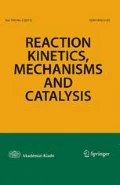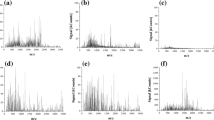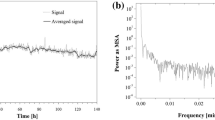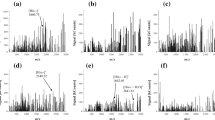Abstract
This is our fourth consecutive study carried out in an order to collect experimental evidence regarding the impact of heavy water (D2O) on the spontaneous oscillatory peptidization of proteinogenic α-amino acids and this time its subject matter is l-hydroxyproline (l-Hyp). Our three earlier studies have been focused on the two sulfur-containing α-amino acids, i.e., l-cysteine (l-Cys) and l-methionine (l-Met), and on one structurally related α-amino acid, i.e., l-proline (l-Pro). It seemed interesting to assess the effect induced by D2O on l-Hyp and to compare it with the effects valid for l-Cys, l-Met, and l-Pro. As analytical techniques, we used high-performance liquid chromatography with the evaporative light-scattering detection (HPLC-ELSD), mass spectrometry (MS), and scanning electron microscopy (SEM). The obtained results make it clear that the impact of heavy water on dynamics of spontaneous peptidization of l-Hyp differs from that exerted on three other α-amino acids discussed (although in all four cases, heavy water significantly hampers spontaneous oscillatory peptidization). With l-Hyp, an increasing proportion of D2O in the reaction mixture results in decreasing yields of both, the soluble lower molecular weight peptides and the insoluble higher molecular weight peptides. With the two sulfur-containing compounds (l-Cys and l-Met), an increasing proportion of D2O in the reaction mixture resulted in growing yields of the soluble lower molecular weight peptides at an expense of decreasing yields of the insoluble higher molecular weight peptides. With l-Pro, still different pattern was observed, namely that the hampering effect of D2O on peptidization was not monotonously dependent on the concentration of D2O in the system, but it was the strongest pronounced for 10% (v/v) D2O in the employed binary methanol–water solvent (with the investigated proportions of D2O in this solvent changing from 0 to 30%). We hope that firm quantitative results presented in this study (and also in the three earlier studies from this cycle) can prove an inspiration for future researchers interested in getting a deeper insight into the role of D2O in life processes, and more specifically in the kinetic and mechanistic aspects thereof. Perhaps it might be noteworthy to add that out of four α-amino acids investigated so far, which can be divided into two groups of the endogenous (l-Cys and l-Pro) and exogenous (l-Met and l-Hyp) species, the endogenous species undergo spontaneous peptidization following the circadian rhythm, whereas the exogenous ones (including l-Hyp) do not.


Similar content being viewed by others
References
Sajewicz M, Piętka R, Pieniak A, Kowalska T (2005) Application of thin-layer chromatography (TLC) to investigating oscillatory instability of the selected profen enantiomers. Acta Chromatogr 15:131–149
Sajewicz M, Piętka R, Pieniak A, Kowalska T (2006) Application of thin-layer chromatography to the investigation of oscillatory instability of selected profen enantiomers in physiological salt. J Liq Chromatogr Relat Technol 29:2059–2069
Sajewicz M, Piętka R, Drabik G, Kowalska T (2006) On the mechanism of oscillatory changes of the retardation factor (RF) and the specific rotation [α]D with selected solutions of S-(+)-naproxen. J Liq Chromatogr Relat Technol 29:2071–2082
Sajewicz M, Kronenbach D, Gontarska M, Wróbel M, Piętka R, Kowalska T (2009) TLC in search for structural limitations of spontaneous oscillatory in-vitro chiral conversion α-hydroxybutyric and mandelic acids. J Planar Chromatogr-Mod TLC 22:241–248
Sajewicz M, Kronenbach D, Gontarska M, Kowalska T (2010) TLC and polarimetric investigation of the oscillatory in vitro chiral conversion of R-β-hydroxybutyric acid. J Liq Chromatogr Relat Technol 33:1047–1057
Sajewicz M, Kronenbach D, Gontarska M, Kowalska T (2008) TLC and polarimetric investigation of the oscillatory in-vitro chiral inversion of l-alanine. J Planar Chromatogr-Mod TLC 21:43–47
Sajewicz M, Matlengiewicz M, Leda M, Gontarska M, Kronenbach D, Kowalska T, Epstein IR (2010) Spontaneous oscillatory in vitro chiral conversion of simple carboxylic acids and its possible mechanism. J Phys Org Chem 23:1066–1073
Sajewicz M, Dolnik M, Kronenbach D, Gontarska M, Kowalska T, Epstein IR (2011) Oligomerization oscillations of l-lactic acid in solutions. J Phys Chem A 115:14331–14339
Sajewicz M, Dolnik M, Kowalska T, Epstein IR (2014) Condensation dynamics of l-proline and l-hydroxyproline in solution. RCS Adv 4:7330–7339
Godziek A, Maciejowska A, Talik E, Wrzalik R, Sajewicz M, Kowalska T (2016) On spontaneously pulsating proline-phenylalanine peptide microfibers. Curr Protein Pept Sci 17:106–116
Maciejowska A, Godziek A, Talik E, Sajewicz M, Kowalska T, Epstein IR (2016) Scanning electron microscopic evidence of spontaneous heteropeptide formation in abiotic solutions of selected α-amino acid pairs. J Chromatogr Sci 54:1301–1309
Godziek A, Maciejowska A, Talik E, Sajewicz M, Kowalska T (2016) Scanning electron microscopic evidence of spontaneous heteropeptide formation in abiotic solutions of selected α‐amino acid pairs. Israel J Chem 56:1057–1066
Fulczyk A, Łata E, Dolnik M, Talik E, Kowalska T, Sajewicz M (2018) Impact of D2O on peptidization of l-cysteine. Reac Kinet Mech Cat 125:555–565
Fulczyk A, Łata E, Kowalska T, Sajewicz M (2019) Unpublished results
Fulczyk A, Łata E, Talik E, Kowalska T, Sajewicz M (2019) Impact of D2O on peptidization of l-methionine. Reac Kinet Mech Cat 126:939–949
Shalayel I (2018) A plausible prebiotic synthesis of thiol-rich peptides: the reaction of aminothiols with aminonitriles. PhD Thesis, Université Grenoble Alpes, Grenoble, France
Maciejowska A, Godziek A, Talik E, Sajewicz M, Kowalska T (2015) Investigation of spontaneous chiral conversion and oscillatory peptidization of l-methionine by means of TLC and HPLC. J Liq Chromatogr Relat Technol 38:1164–1171
Godziek A, Maciejowska A, Sajewicz M, Kowalska T (2016) Dynamics of spontaneous peptidization of l-, d- and dl-serine in an abiotic solution as investigated with use of TLC-densitometry and the auxiliary chromatographic techniques. J Chromatogr Sci 54:1090–1095
Katz JJ, Crespi HL, Czajka DM, Finkel AJ (1962) Course of deuteriation and some physiological effects of deuterium in mice. Am J Physiol 203:907–913
Bachner P, McKay DG, Rittenberg D (1964) The pathological anatomy of deuterium intoxication. Proc Natl Acad Sci USA 51:464–471
Richter CP (1976) A study of taste and smell of heavy water (98%) in rats. Proc Soc Exp Biol Med 152:677–684
Richter CP (1977) Heavy water as a tool for study of the forces that control length of period of the 24-hour clock of the hamster. Proc Natl Acad Sci USA 74:1295–1299
Kanto U, Clawson AJ (1980) Use of deuterium oxide for the in vivo prediction of body composition in female rats in various physiological states. J Nutr 110:1840–1848
Litvinenko LA, Kravchuk LA, Petrikevich SB, Sakharovskii VG, Ivanitskaia JG, Guliamova DE (1992) Effect of heavy water on the growth, glucose assimilation and stability of Escherichia coli to freezing-thawing. Mikrobiologiia 61:1030–1037 (in Russian)
Schroeter D, Lamprecht J, Eckhardt R, Futterman G, Paweletz N (1992) Deuterium oxide (heavy water) arrests the cell cycle of PtK2 cells during interphase. Eur J Cell Biol 58:365–370
Takeda H, Nio Y, Omori H, Uegaki K, Hirahara N, Sasaki S, Tamura K, Ohtani H (1998) Mechanisms of cytotoxic effects of heavy water (deuterium oxide: D2O) on cancer cells. Anticancer Drugs 9:715–725
Kushner DJ, Baker A, Dunstall TG (1999) Pharmacological uses and perspectives of heavy water and deuterated compounds. Can J Physiol Pharmacol 77:79–88
Busch R, Kim Y, Neese RA, -Serin V, Collins M, Awada M, Gardner JL, Beysen C, Marino ME, Misell LM, Hellerstein MK (2006) Measurement of protein turnover rates by heavy water labeling of nonessential amino acids. Biochim Biophys Acta 1760:730–744
Demidov VV (2007) Heavy isotopes to avert ageing? Trends Biotechnol 25:371–375
Kumar N, Attri P, Kumar Yadav D, Choi J, Choi EH, Uhm HS (2014) Induced apoptosis in melanocytes cancer cell and oxidation in biomolecules through deuterium oxide generated from atmospheric pressure non-thermal plasma jet. Sci Rep. https://doi.org/10.1038/srep07589
Fulczyk A, Łata E, Talik E, Kowalska T, Sajewicz M (2019) Impact of D2O on peptidization of l-proline. Reac Kinet Mech Cat. https://doi.org/10.1007/s11144-019-01681-y
Neuman RE, Logan MA (1950) The determination of hydroxyproline. J Biol Chem 184:299–306
Hu CA, Khalil S, Zhaorigetu S, Liu Z, Tyler M, Wan G, Valle D (2008) Human delta 1-pyrroline-5-carboxylate synthase: function and regulation. Amino Acids 35:665–672
Nagelschmidt M, Struck H (1977) Hydroxyproline as a parameter of collagen metabolism. Med Welt 28:334–335 (in German)
Srivastava AK, Khare P, Raghuwanshi N, Nagar H, Srivastava R (2016) Hydroxyproline: a potential biochemical marker and ist role in the pathogenesis of different diseases. Curr Protein Pept Sci 17:596–602
Gabr S, Alghadir AH, Sherif YE, Ghfar AA (2017) Hydroxyproline as a biomarker of liver disease. In: Patel VB, Preedy VR (eds) Biomarkers in liver disease. Springer, Dordrecht, pp 3–21
López B, González A, Ravassa S, Beaumont J, Moreno MU, San José G, Querejeta R, Díez J (2015) Circulating biomarkers of myocardial fibrosis: the need for a reappraisal. J Am Coll Cardiol 65:2449–2456
Jantos-Siwy J, Schiffer E, Brand K, Schumann G, Rossing K, Delles C, Mischak H, Metzger J (2009) Quantitative urinary proteome analysis for biomarker evaluation in chronic kidney disease. J Proteome Res 8:268–281
Maciejowska A, Godziek A, Sajewicz M, Kowalska T (2017) Circadian rhythm of spontaneous non-linear peptidization with proteinogenic amino acids in abiotic solutions versus homochirality. Acta Chromatogr 29:135–142
Simsek B, Karacaer O, Karaca I (2004) Urine products of bone breakdown as markers of bone resorption and clinical usefulness of urinary hydroxyproline: an overview. Chin Med J 117:291–295 (in English)
Author information
Authors and Affiliations
Corresponding author
Additional information
Publisher's Note
Springer Nature remains neutral with regard to jurisdictional claims in published maps and institutional affiliations.
Electronic supplementary material
Below is the link to the electronic supplementary material.
Rights and permissions
About this article
Cite this article
Fulczyk, A., Łata, E., Talik, E. et al. Impact of D2O on peptidization of l-hydroxyproline. Reac Kinet Mech Cat 129, 17–28 (2020). https://doi.org/10.1007/s11144-019-01711-9
Received:
Accepted:
Published:
Issue Date:
DOI: https://doi.org/10.1007/s11144-019-01711-9




